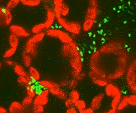Plant Pathology, Department of

Department of Plant Pathology: Faculty Publications
Document Type
Article
Date of this Version
January 2007
Abstract
A new plant virus belonging to the family Luteoviridae and isolated from diseased oat (Avena sativa L.) plants was discovered in Alaska in 2003. Even though plants with red/orange leaves were indicative of barley yellow dwarf disease, they were not reactive to specific antibodies corresponding to barley yellow dwarf virus (BYDV)-MAV, -PAV, -SGV, and cereal yellow dwarf virus-RPV from enzyme-linked immunosorbent assays (ELISA). An alternative RT-PCR assay that incorporated Shu-F/Yan-R primers for detection of BYDV-MAV, -PAS, -PAV, and SGV was effective in producing ~830-nt fragments that contained genomic sequences to the 3’-terminus of the polymerase gene (ORF 2), the intergenic region (~113 nt), the coat protein gene (ORF 3), and the putative movement gene (ORF 4). The Alaskan isolates were most similar to BYDV-MAV with only about 77 and 80% amino acid identity in the CP and ORF 4, respectively. The Alaska isolates coat protein gene sequences differed in several regions that otherwise are conserved among BYDV-MAV isolates, and may be important in serological variations, accounting for the negative ELISA results. Based upon sequence and serological differences, we concluded that the Alaskan BYDV-MAV-like isolates formed a novel species tentatively in the genus Luteovirus, and propose the name BYDV-ORV (oat red-leaf virus).


Comments
Published in Arch Virol (2007) 152: 369–382.